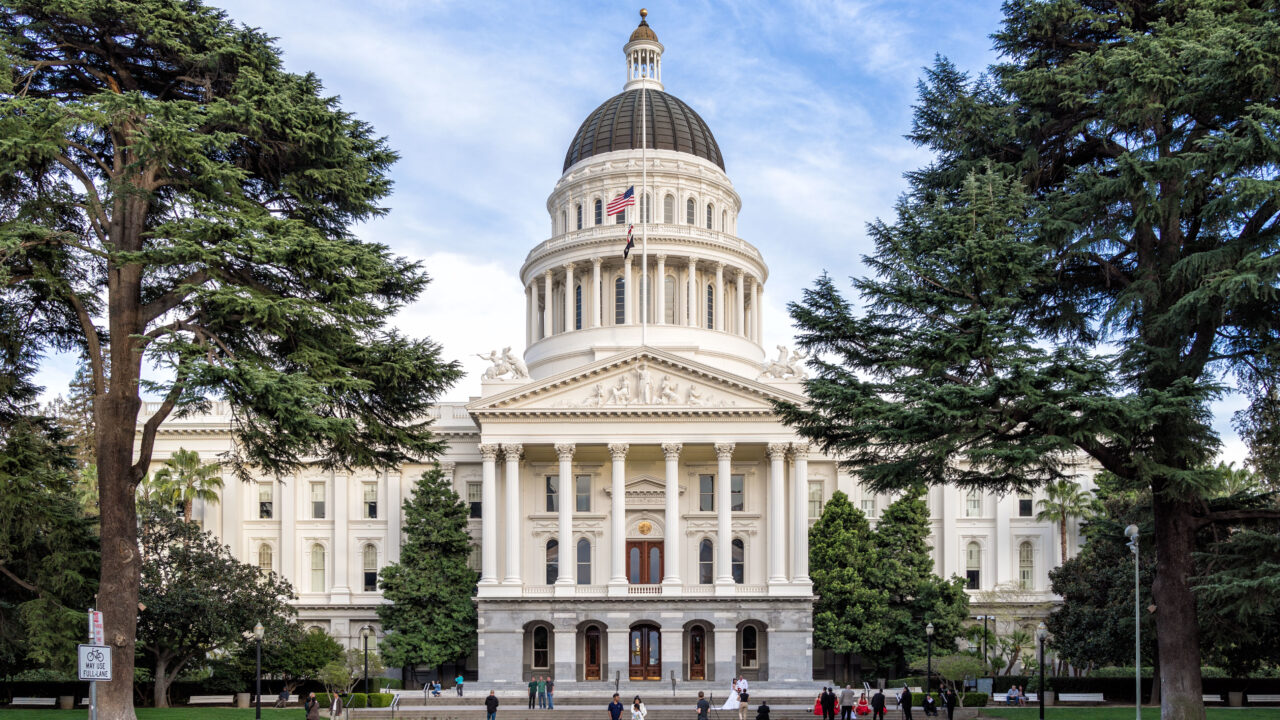The Farce of California’s Budget Deficit
Tax breaks, mostly for industrial companies and wealthy households, add up to more than double the expected deficit. California State Capital / Wikimedia Commons
California State Capital / Wikimedia Commons
Every year, state financial analysts offer up a dutiful tally of the billions of dollars that California forgoes in revenue due to the tax breaks it offers cable companies, timber companies, the oil and gas industry, homeowners, renters, parents of young children and lottery winners, to name a few who reap such rewards.
All told, these so-called tax expenditures total nearly $70 billion, with many of the benefits going to higher income households and to businesses, according to the Sacramento-based California Budget and Policy Project. Unlike the budget, none of the tax breaks are subject to annual review. That, says Alissa Anderson, senior policy analyst at the Budget Center, is a problem.
“They just sort of live on year after year in the tax code. They’re not part of the budget conversation,” she said. While it requires only a majority vote of the Legislature to adopt a tax break, it requires a two-thirds vote to eliminate one.
California now faces a $24 billion budget shortfall. That’s assuming there is no recession. Gov. Gavin Newsom says he will maintain current spending levels for social programs, but advocates say the safety net needs shoring up. Wage growth is not keeping up with inflation, and $500 million in monthly pandemic-related federal food assistance is disappearing at the end of March.
“The need has not gone back down to pre-pandemic levels by any stretch of the imagination,” says Claudia Bonilla Keller, CEO of Second Harvest Food Bank, which serves working families, college students, seniors and homeless people in Orange County. Keller estimates that her food pantry network serves 370,000 people a month, up from 249,000 per month in 2019.
Those circumstances may explain why the California State Assembly’s Revenue and Taxation Committee is holding a hearing on tax expenditures on Feb. 22 entitled “Spending on Autopilot.”
California, as it turns out, trails other states, including Texas and Florida, when it comes to evaluating its tax incentives, according to a report by the Pew Charitable Trusts. Former state Sen. Hannah-Beth Jackson attempted to remedy this in 2019 and then again in 2020 with bills that would have required an evaluation of some of the state’s largest corporate tax breaks.
The Budget Center calculates that had California’s corporations been paying the same share of their income that they did in the early 1980s, the state would have had $14.4 billion more in its coffers in 2019.
The bill Jackson introduced in 2019 would have created a board to review major tax expenditures and make recommendations to the legislature. It was approved by state lawmakers but vetoed by Gov. Newsom after 57 businesses, trade associations, and taxpayer groups rallied in opposition, including the California Taxpayers’ Association. “That always makes me chuckle because they pretend like they really care about the taxpayer,” said Jackson, who now runs a strategic consulting firm in Santa Barbara.
The bill’s opponents said it would have created a “new and potentially costly bureaucracy” to carry out the oversight function. Newsom’s veto message said he believed tax expenditures should be “scrutinized periodically to justify their overall cost to the state’s revenue base.” However, he opposed the creation of a new board and said the state’s existing reporting requirements were adequate.
Another bill Jackson introduced in 2020 that would have put University of California researchers in charge of assessing large corporate tax breaks did not make it to the governor’s desk. “The public deserves to know whether the benefits are worth their costs or whether that funding could be put to better use, for example, for our schools,” Jackson said.
In the absence of the kind of review that Jackson pushed, it’s still possible to learn a few things about the state’s tax breaks from published reports:
- Homeowners will receive $3.9 billion in tax breaks the 2022-23 fiscal year from the home mortgage interest deduction, about 24 times more than renters receive through the renters’ credit.
- The state’s largest corporate tax break — valued at $4.4 billion — is called the “water’s edge” election. It allows multinational companies to exclude from their reportable earnings business conducted in foreign countries. The tax break may have an unintended consequence: allowing corporations to shield income in offshore tax havens, according to a 2016 state auditor’s report. The cost to the state of this tax break has increased sixfold since 2012 when it was valued at $700 million.
- The second largest corporate tax break, a credit for research and development, mostly benefits companies with revenues of greater than a billion dollars. There was “insufficient evidence” to determine whether the R&D tax credit had fulfilled its purpose, according to the auditor’s report. That credit is estimated to cost the state $2.3 billion during this fiscal year.
Meanwhile, California corporations are contributing about half as much of their profits in state taxes than they did a generation ago due to reductions in the tax rate in the 1980s and 1990s. The tax breaks have also contributed to the reduction in California corporations’ tax burden, according to the Budget Center.
The Budget Center calculates that had California’s corporations been paying the same share of their income that they did in the early 1980s, the state would have had $14.4 billion more in its coffers in 2019, “more than the state spends on the University of California, the California State University, and student aid combined.”
Jackson says some of the tax incentives may be providing benefits. She just wants to know if they are fulfilling their purpose.
One of the major challenges facing policymakers who want to throttle back on corporate tax breaks is that states are in competition with one another, creating what critics say is a race to the bottom.
One tax credit that does come up for periodic review is the film and television tax credit program. Newsom proposes to extend that credit and expand it to $330 million per year for five years, beginning in 2025-26. Jackson counts the tax credit’s periodic review as “good governance.” It has broad support from the film and television industry and the labor unions that represent its workers.
But the Budget Center’s Jonathan Kaplan, who has authored recent reports on tax expenditures, is skeptical that the credit represents a good return on investment for California’s taxpayers, especially in a difficult budget year. “Don’t pass more tax credits at the very time that you are losing revenue unless you can clearly demonstrate that it’s achieving your objective,” Kaplan said.
A Legislative Analyst Office’s report found that the costs of the film and television tax break program exceeded its benefits. “While the credit probably caused some film and television projects to be made here, many other similar projects also were made here without receiving any financial incentive,” according to the LAO.
One of the major challenges facing policymakers who want to throttle back on corporate tax breaks is that states are in competition with one another, creating what critics say is a race to the bottom. “California is doing what it’s doing defensively,” said Greg LeRoy, executive director of Good Jobs First, a nonpartisan research organization based in Washington, D.C., that monitors corporate tax breaks and subsidies.
Tax breaks can go away. LeRoy noted that “a political rainbow of actors” came together to roll back a multibillion dollar tax incentive program benefiting energy companies in Texas as a way to fund schools. A decade ago, at the height of the Great Recession, California abolished its enterprise zone program, which was aimed at creating jobs in economically distressed parts of the state but was deemed an ineffective giveaway to large corporations.
For tax expenditure programs to end, “There has to be a campaign, maybe a horror story,” LeRoy said.
Your support matters…Independent journalism is under threat and overshadowed by heavily funded mainstream media.
You can help level the playing field. Become a member.
Your tax-deductible contribution keeps us digging beneath the headlines to give you thought-provoking, investigative reporting and analysis that unearths what's really happening- without compromise.
Give today to support our courageous, independent journalists.




You need to be a supporter to comment.
There are currently no responses to this article.
Be the first to respond.